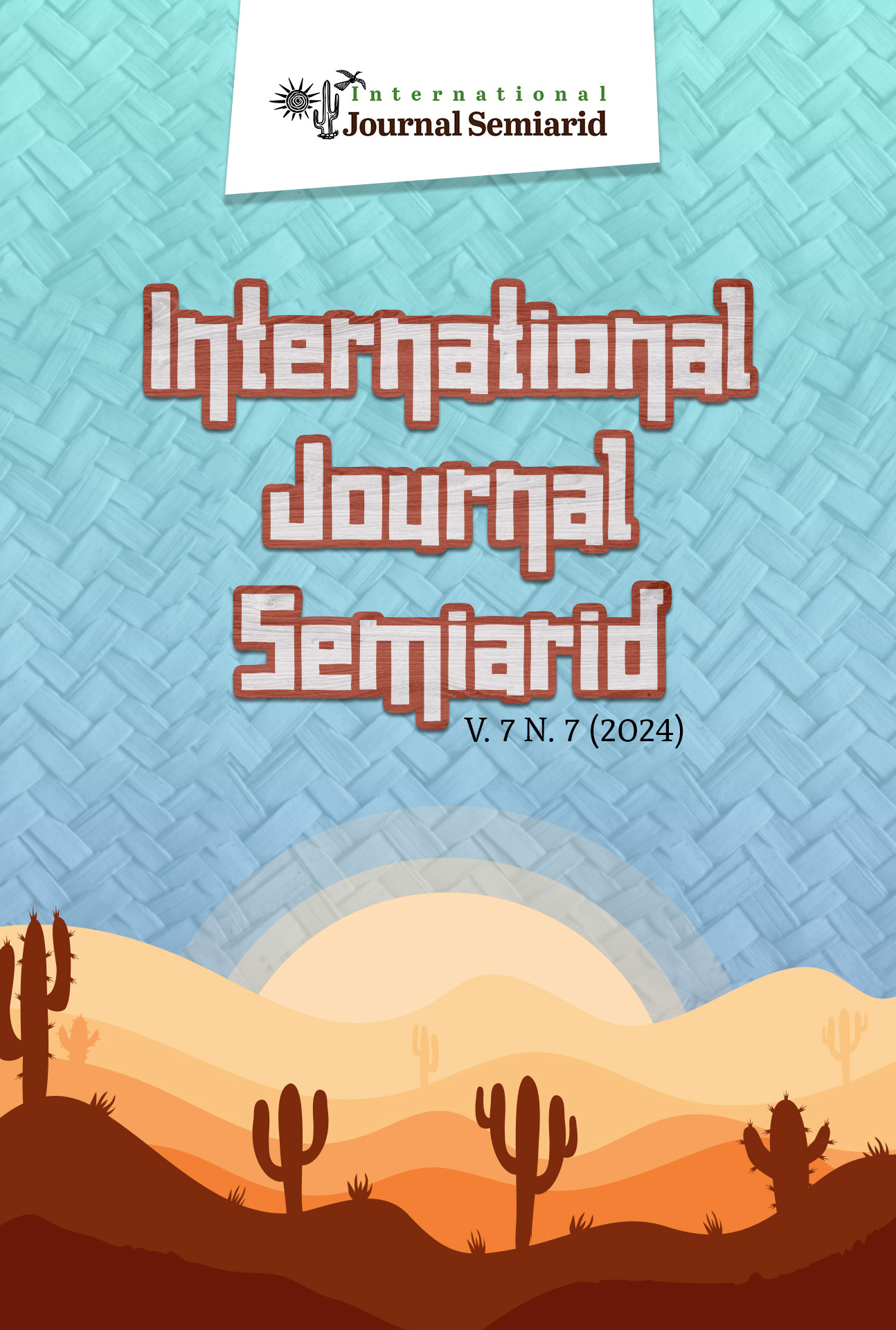ANALYSIS OF THE USE AND OCCUPATION OF THE GRUTA DO MAGE GEOSITE: CONTRIBUTION TO THE BIOGEOGRAPHY OF THE INSELBERGUES FIELD
DOI:
https://doi.org/10.56346/ijsa.v7i7.209Keywords:
Inselberg, Biogeography, caatingaAbstract
The Inselbergs of Quixadá, formations carved out of granite rocks, represent crucial ecosystems due to their specific environmental conditions, including a unique microclimate that makes them rich in diversity and distinct vegetational characteristics, giving these landscapes intense exuberance. This research aims to analyze the impacts of land use and occupation on the Gruta do Magé Geosite. Specifically, it seeks to identify existing land uses and occupations and to carry out a preliminary characterization of the flora of the study area. To achieve these objectives, the walking method of Filgueiras et al. (1994) was used. The results indicate various signs of human activity, such as the presence of pastures, deforestation, solid waste on the trail and the dispersal of invasive species, resulting from practices such as agriculture, tourism and recreation. Despite these threats, the preliminary characterization of the flora reveals a remarkable wealth of vegetation on the rocky outcrop and its surroundings. The significant contribution of biogeography in inselbergs stands out, especially in the analysis and protection of biotic and abiotic elements. This approach involves understanding the interaction of these factors, the distribution of species and defining means for conserving biodiversity and geodiversity in these areas. Thus, the research not only highlights the challenges faced by the Magé Cave due to human activities, but also underscores the importance of integrated approaches to preserving these unique ecosystems.
References
AB’SABER. A.N. Os Domínios de natureza do Brasil: potencialidades paisagísticas. 1ª edição. São Paulo. Ateliê, 2003.
BERTRAND, G. Paisagem e geografia física global: esboço metodológico. Caderno de Ciências da Terra, n. 13, p. 1-27, 1971.
BORGES, Thalita. O Uso da biogeografia para análise ambiental do refúgio de vida silvestre dos Rios Tijuco e da Prata em Ituiutaba (MG). Dissertação (Mestrado em Geografia) - Universidade Federal de Uberlândia, Ituiutaba, 2019.
BRASIL, Banco de Dados de Informações Ambientais. Vegetação. Disponível em: https://bdiaweb.ibge.gov.br/#/consulta/vegetacao. Acesso em: 17 nov. 2023.
BRASIL, Instituto Brasileiro de Geografia e Estatística. Manual Técnico da Vegetação Brasileira. 2. ed. Rio de Janeiro: IBGE, 2012.
BRASIL, Ministério do Meio Ambiente (MMA). Ecossistemas: Bioma Caatinga, 2022. Disponível em: https://www.gov.br/mma/pt-br/assuntos/ecossistemas-1/biomas/caatinga. Acesso em: 01 nov. 2023.
BRILHA J. Património geológico e geoconservação: a conservação da natureza na sua vertente geológica. Viseu: Palimage Editores, 2005. 190p.
FERNANDES, Moabe; Queiroz, Luciano. Vegetação e flora da Caatinga. Ciência e Cultura, v. 70, n. 4, p. 51-56, 2018.
FREITAS, L. C. B.; MONTEIRO, F. A. D.; FERREIRA, R. V.; MAIA, R. P. (Org.) Geoparque Sertão Monumental - CE: proposta. Fortaleza: CPRM, 2019.
GRAY, M. Geodiversity and Geoconservation: what, why, and how? Geodiversity & Geoconservation, 2005. Disponível em: http://www.georgewright.org/223gray.pdf. Acesso em: 17 nov. 2023.
MAIA, R. P. & NASCIMENTO, M. A. N. Relevos Graníticos do Nordeste Brasileiro. Revista Brasileira de Geomorfologia. V. 18, nº 2, 2018.
MORO, M. F.; MACEDO, M. B.; MOURA-FÉ, M. M.; CASTRO, A. S. F.; COSTA, C. R. C. Vegetação, unidades fitoecológicas e diversidade paisagística do estado do Ceará. Rodriguésia, v. 66, n. 3, p. 717-743, 2015.
OLÍMPIO, J. L. S.; MONTEIRO, F. A. D.; FREITAS, L. C. B.;ALMEIDA, L. T. de; ALCÂNTARA, A. P. de; LOUREIRO, C. V.; NASCIMENTO, M. L; MAIA, R. P. O que sabemos sobre os inselbergues de Quixadá e Quixeramobim, Nordeste do Brasil?. William Morris Davis - Revista de Geomorfologia, v. 2, n. 1, p. 19- 42, 2021.
PAULINO, R.; GOMES, V.; SILVEIRA, A. P. Flora De inselbergues do Monumento Natural Monólitos De Quixadá, no sertão central do Ceará. Iheringia, Série Botânica, v. 73, n. 2, p. 182-190, 2018.
PORTO, P. A. F.; ALMEIDA, A.; PESSOA, W. J.; TROVÃO, D.; FELIX, L. P. Composição Florística de um Inselbergue no Agreste Paraibano, Município de Esperança, Nordeste Do Brasil. Revista Caatinga (Mossoró, Brasil), v.21, n.2, p.214-, abril/junho de 2008.
POREMBSKY, Stefan. Tropical inselbergs: habitat types, adaptive strategies and diversity patterns. Revista Brasileira de Botânica, São Paulo, v. 30, n. 4, p. 579-586, 2007.
SOUZA, S. D. G. de; SOUZA, A. C. N de; SOUSA, M. L. M de. Geodiversidade, Geoparque e Semiárido brasileiro: a valorização do ambiente para o desenvolvimento territorial. PerCursos, Florianópolis, v. 23, n. 52, p. 251-281, 2022.
SEMACE, Superintendência Estadual do Meio Ambiente. Reestruturação e atualização do mapeamento do projeto zoneamento ecológico-econômico do Ceará - Zona Costeira e unidades de conservação costeira - Relatório final de caracterização Ambiental e dos Mapeamentos. Fortaleza, Ceará, SEMACE, 2016.
TROPPMAIR, H. Biogeografia e Meio Ambiente. 9. ed. Rio de Janeiro: Technical Books, 2012.
URQUIZA, Nazareth; CARVALHO, Julluanna; CORRÊA, Christiane; PIMENTEL, Leonardo; PIFANO, Daniel; RODRIGUES, Renato. Guia de propágulos e plântulas da Caatinga. Núcleo de Ecologia e Monitoramento Ambiental (Nema) – UNIVASF. Petrolina – PE, Cogito, 2019.


